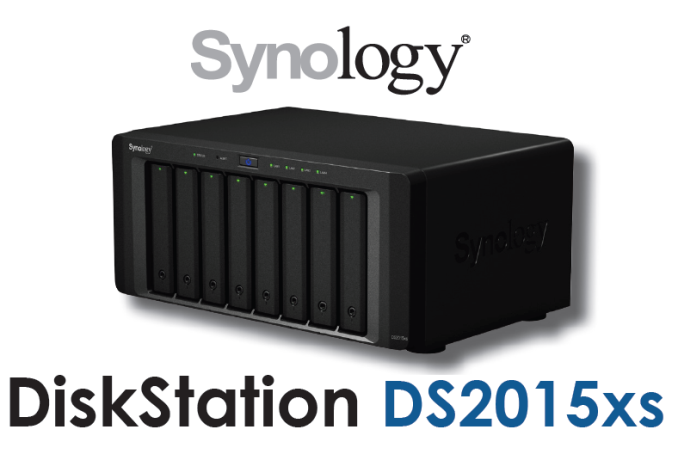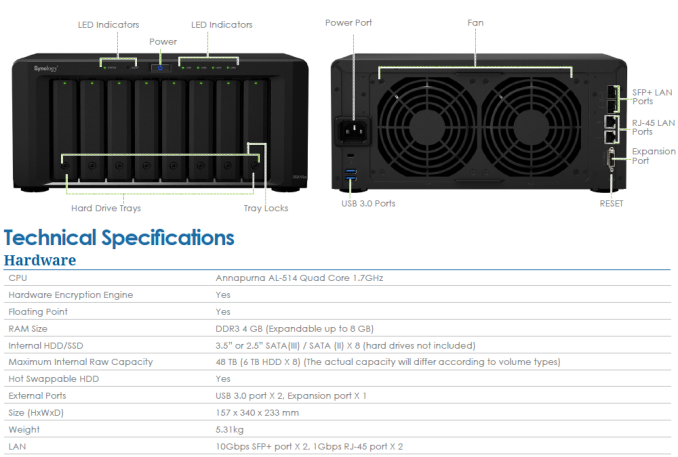Synology's DS2015xs brings ARM to High-Performance NAS Units
by Ganesh T S on December 9, 2014 3:00 AM EST- Posted in
- NAS
- Storage
- Arm
- 10G Ethernet
- Synology

In the current NAS market, it is downright impossible to talk of ARM and high performance together. The most powerful ARM-based NAS units have been based on Marvell's ARMADA processors. They usually come with dual gigabit network links and typically target the SOHO and low-end SMB market. Intel's offerings have had a virtual monopoly in the other tiers of the market. Synology is set to change all that with their latest offering - the DS2015xs with native 10G capabilities.
DS2015xs: Features & Specifications
The DS2015xs is 8-bay NAS unit presented as a step-up from the DS1815+. While the DS1815+ can expand up to a total of 18 bays with two DX513 expansion chassis, the DS2015xs is compatible with the 12-bay DX1215 expander (for a total of 20 bays). The main step-up from the DS1815+ is the presence of two built-in 10G SFP+ copper links.
Claimed performance numbers include transfer speeds of up to 2000 MBps and 59K sequenital IOPS.
Platform Details
The SoC at the heart of the DS2015xs is the AL-514 from Annapurna Labs, an Israeli startup that is still in stealth mode. The company has declined to speak to the media as of now. However, tracing some coverage of Israeli VC firms reveals that Annapurna Labs was founded in 2011 with the intent of bringing ARM-based communication processors to the market. Datasheets of SoCs from Annapurna Labs are not currently available to the public, but Synology was kind enough to divulge the following details (which, I suspect, can be gleaned via SSH access to the DS2015xs):
- The AL-514 has four ARM Cortex-A15 cores running at 1.7 GHz
- The Cortex-A15 cores are configured with LPAE (large physical address extension) that allows addressing of more than 4 GB of RAM (the DS2015xs supports up to 8 GB)
- The SoC has two 10G Ethernet MAC IPs integrated
Beyond these, details are scarce. We hope Annapurna Labs comes out of stealth mode soon and supplies us with more details. We might possibly be able to gather more information about the platform once we get the DS2015xs in hand.
Moving on to the relevance of the AL-514 for the ARM ecosystem, it is clear that at least Synology considers it to be a worthy competitor to Intel's Rangeley. The DS2015xs is being positioned as a clear step-up from the Rangeley-based DS1815+. That said, the fact is that A15 is a 32-bit processor, and it is not entirely suitable (despite the LPAE extensions) for high-performance servers. ARM has since moved on to ARMv8 processors (true 64-bit) for both the smartphone and the server / communication infrastructure market.
Related Announcements - DS3615xs and DX1215
In other related news, Synology is also launching the DS3615xs, a native 12-bay desktop form factor solution (expandable to 36 bays with support for two DX1215 expanders). It is a straight-up upgrade to the previous-generation DS3612xs which used a Sandy Bridge-based Core i3-2100. The DS3615xs uses the Haswell Core i3-4130. It comes with four gigabit links, but also has support for a PCIe expansion card (to potentially add 10G capabilities). Like the previous generation xs-units, it comes with ECC RAM (4GB DDR3 by default, expandable to 32GB). Pricing and release date in the Americas for the DS3615xs is not yet available.
The DX1215 is a 12-bay expansion unit for select Synology DiskStation models. Unlike the eSATA-based DX513, the DX1215 connects to the main unit using Infiniband. Further details are available here.
Concluding Remarks
The DS2015xs will retail for $1400 - a price that really makes 10G affordable, while undercutting the introductory pricing of the previous generation xs units significantly. We have to admit that the xs positioning of the unit was initially very surprising. After all, the Cortex A15 really can't stand up to the Core i3 (on which the previous generation xs units have been based) in terms of raw CPU performance. There is no support for ECC RAM either. Synology clarified that the CPU performance would definitely not match up. However, the presence of communication and storage accelerators - particularly, natively integrated 10G capabilities, RAID acceleration and hardware-assisted encryption - enable the DS2015xs to support bandwidths that have typically not been reached at this price point.
While the Annapurna AL-514 SoC seems more like a stop-gap solution for this market segment (particularly when true 64b ARM solutions are starting to make an appearance), consumers are fortunately shielded by Synology's DiskStation Manager (DSM) OS. The operating system manages to isolate the user experience with various NAS aspects from the underlying platform architecture. The end-user experience is the same, regardless of whether the NAS being used is based on ARM or x86.
On the whole, Synology seems to have hit a home run with the price to performance ratio in the DS2015xs. We hope to soon have a unit in hand to test out how it performs with our standardized lab environment. We would also like to hear from readers on what sort of applications they are running on their Synology NAS units. This would help us determine how much of a performance difference there is between, say, the DS1815+ and the DS2015xs, for applications that matter to end users.
Source: Synology











27 Comments
View All Comments
duploxxx - Tuesday, December 9, 2014 - link
might see a few more desings like this once companys like AMD start building the server based ARM. initial release Seattle for example:http://www.anandtech.com/show/8362/amds-big-bet-on...
eanazag - Tuesday, December 9, 2014 - link
The specs are good. It is too expensive to me for personal use even with two 10GbE interfaces. I would suspect RAID rebuild times suck.Do these type systems support hardware drive encryption in the likes of Microsoft's edrive in the storage OS?
eanazag - Tuesday, December 9, 2014 - link
I'm asking about the ARM based device.UltraWide - Tuesday, December 9, 2014 - link
It's most likely volume encryption with the aid of hardware AES-type offload instruction set ala intel AES-NI.diamondsw - Tuesday, December 9, 2014 - link
Well, you certainly wouldn't want to run the whole thing as a RAID-5 volume, that's for sure. That said, modern NAS units can rebuild a failed 4-6TB volume surprisingly quickly, and 8 bays in the base unit make it more likely you can afford to use dual disk redundancy to protect against failures during the rebuild process, which substantially mitigates a long rebuild time.ZarnoththeDestroyer - Monday, December 15, 2014 - link
Their rebuild on the DS1812, DS1813 is artificially limited. Single drive or consistency check with 4TB drives can take 3-5+ days. You can SSH in and speed it up if you know what your doing. Beware that the drives they say are supported aren't really in some cases. The kernel is a monolithic zimage that uncompresses into running memory. They have compiled modules with out dates drivers that have issues. (You cant modify see above.) Specifically Marvel controller chipset and modified them so that it will only accept their Synology branded expansion modules.diamondsw - Tuesday, December 9, 2014 - link
When will we see real-world use of 10GbaseT (I could have sworn recent NetGear units were using it)? SFP is okay for now, but is much more likely to be used in light datacenter applications. We won't see much prosumer adoption until 10GbaseT as SFP switches are just too expensive.Peeping Tom - Tuesday, December 9, 2014 - link
I was wondering the same thing. Prefer RJ-45 myself. SFP copper cables are like $20 a foot. LOLganeshts - Tuesday, December 9, 2014 - link
Yes, the cables are quite costly at the moment.However, you can get core aggregation switches (10G SFP+ ports + multiple 1G ports) for around the same price as that of this unit : ~$1500 ; The one that Franklin @ Synology used here : http://blog.synology.com/blog/?p=2020 : is an example with 4x 10G SFP+ ports.
For our testbed, we use the GSM7352S - that has 2x 10G SFP+ ports and 48x 1G ports - but, it is a bit more costly than what Franklin uses in the above test.
mervincm - Tuesday, December 9, 2014 - link
What are 10G SFP+ copper links?Do you mean that it has 2 SFP+ slots and includes a pair of 10G copper transceivers?